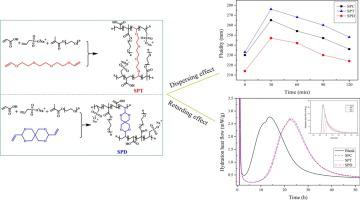当前位置:
X-MOL 学术
›
Colloids Surf. A Physicochem. Eng. Aspects
›
论文详情
Our official English website, www.x-mol.net, welcomes your feedback! (Note: you will need to create a separate account there.)
Effect of the cross-linker structure of cross-linked polycarboxylate superplasticizers on the behavior of cementitious mixtures
Colloids and Surfaces A: Physicochemical and Engineering Aspects ( IF 5.2 ) Pub Date : 2021-01-01 , DOI: 10.1016/j.colsurfa.2020.125437 Xiuju Lin , Hao Pang , Daidong Wei , Mangeng Lu , Bing Liao
Colloids and Surfaces A: Physicochemical and Engineering Aspects ( IF 5.2 ) Pub Date : 2021-01-01 , DOI: 10.1016/j.colsurfa.2020.125437 Xiuju Lin , Hao Pang , Daidong Wei , Mangeng Lu , Bing Liao

|
Abstract At present, several researchers mainly focus on the synthesis of new micro-cross-linking structure, or explore the effect of cross-linkers with different molecular weight and similar structure on the performance of cross-linked polycarboxylate superplasticizers. In order to explore the influence of the different molecular structure of the cross-linker on the performance of polycarboxylate superplasticizers, two kinds of cross-linked polycarboxylate superplasticizers were synthesized in this study. These two superplasticizers incorporated either a linear cross-linker triethylene glycol diethyl ether or a cyclic cross-linker 3,9-divinyl-2,4,8,10-tetroxyspiro[ 5 , 5 ] undecane as one of the monomers. Then the polymers were respectively coded as SPT and SPD. Furthermore, the dispersion performance of the cross-linked polymers was evaluated by cement slurry fluidity tests and scanning electron microscopy (SEM) characterization. Consequently, cementitious mixtures incorporating SPT had better dispersibility than those incorporating conventional comb-type polycarboxylate superplasticizers (SPC) and SPD. In addition, the XRD, thermogravimetric analysis (TGA), hydration heat, and setting time tests confirmed that SPT exhibited a stronger retardation effect on cement hydration than that was provided by SPD. It was also found that SPT enhanced the compressive strength of concrete, compared to SPC and SPD. This study provides a reference for the development of cross-linked polycarboxylate superplasticizer.
中文翻译:

交联聚羧酸减水剂的交联剂结构对胶结混合物性能的影响
摘要 目前,几位研究人员主要关注新型微交联结构的合成,或探索不同分子量、结构相似的交联剂对交联聚羧酸减水剂性能的影响。为了探讨交联剂的不同分子结构对聚羧酸减水剂性能的影响,本研究合成了两种交联聚羧酸减水剂。这两种超增塑剂结合了线性交联剂三甘醇二乙醚或环状交联剂 3,9-二乙烯基-2,4,8,10-四氧螺[5, 5]十一烷作为单体之一。然后将聚合物分别编码为SPT和SPD。此外,通过水泥浆流动性测试和扫描电子显微镜 (SEM) 表征评估交联聚合物的分散性能。因此,掺入 SPT 的水泥混合物比掺入传统梳型聚羧酸减水剂 (SPC) 和 SPD 的水泥混合物具有更好的分散性。此外,XRD、热重分析(TGA)、水化热和凝结时间测试证实,SPT 比 SPD 对水泥水化具有更强的延缓作用。还发现与 SPC 和 SPD 相比,SPT 提高了混凝土的抗压强度。该研究为开发交联聚羧酸减水剂提供了参考。加入 SPT 的水泥混合物比加入传统梳型聚羧酸减水剂 (SPC) 和 SPD 的水泥混合物具有更好的分散性。此外,XRD、热重分析(TGA)、水化热和凝结时间测试证实,SPT 比 SPD 对水泥水化具有更强的延缓作用。还发现与 SPC 和 SPD 相比,SPT 提高了混凝土的抗压强度。该研究为开发交联聚羧酸减水剂提供了参考。加入 SPT 的水泥混合物比加入传统梳型聚羧酸减水剂 (SPC) 和 SPD 的水泥混合物具有更好的分散性。此外,XRD、热重分析(TGA)、水化热和凝结时间测试证实,SPT 比 SPD 对水泥水化具有更强的延缓作用。还发现与 SPC 和 SPD 相比,SPT 提高了混凝土的抗压强度。该研究为开发交联聚羧酸减水剂提供了参考。凝结时间试验证实,与 SPD 相比,SPT 对水泥水化具有更强的延缓作用。还发现与 SPC 和 SPD 相比,SPT 提高了混凝土的抗压强度。该研究为开发交联聚羧酸减水剂提供了参考。凝结时间试验证实,与 SPD 相比,SPT 对水泥水化具有更强的延缓作用。还发现与 SPC 和 SPD 相比,SPT 提高了混凝土的抗压强度。该研究为开发交联聚羧酸减水剂提供了参考。
更新日期:2021-01-01
中文翻译:

交联聚羧酸减水剂的交联剂结构对胶结混合物性能的影响
摘要 目前,几位研究人员主要关注新型微交联结构的合成,或探索不同分子量、结构相似的交联剂对交联聚羧酸减水剂性能的影响。为了探讨交联剂的不同分子结构对聚羧酸减水剂性能的影响,本研究合成了两种交联聚羧酸减水剂。这两种超增塑剂结合了线性交联剂三甘醇二乙醚或环状交联剂 3,9-二乙烯基-2,4,8,10-四氧螺[5, 5]十一烷作为单体之一。然后将聚合物分别编码为SPT和SPD。此外,通过水泥浆流动性测试和扫描电子显微镜 (SEM) 表征评估交联聚合物的分散性能。因此,掺入 SPT 的水泥混合物比掺入传统梳型聚羧酸减水剂 (SPC) 和 SPD 的水泥混合物具有更好的分散性。此外,XRD、热重分析(TGA)、水化热和凝结时间测试证实,SPT 比 SPD 对水泥水化具有更强的延缓作用。还发现与 SPC 和 SPD 相比,SPT 提高了混凝土的抗压强度。该研究为开发交联聚羧酸减水剂提供了参考。加入 SPT 的水泥混合物比加入传统梳型聚羧酸减水剂 (SPC) 和 SPD 的水泥混合物具有更好的分散性。此外,XRD、热重分析(TGA)、水化热和凝结时间测试证实,SPT 比 SPD 对水泥水化具有更强的延缓作用。还发现与 SPC 和 SPD 相比,SPT 提高了混凝土的抗压强度。该研究为开发交联聚羧酸减水剂提供了参考。加入 SPT 的水泥混合物比加入传统梳型聚羧酸减水剂 (SPC) 和 SPD 的水泥混合物具有更好的分散性。此外,XRD、热重分析(TGA)、水化热和凝结时间测试证实,SPT 比 SPD 对水泥水化具有更强的延缓作用。还发现与 SPC 和 SPD 相比,SPT 提高了混凝土的抗压强度。该研究为开发交联聚羧酸减水剂提供了参考。凝结时间试验证实,与 SPD 相比,SPT 对水泥水化具有更强的延缓作用。还发现与 SPC 和 SPD 相比,SPT 提高了混凝土的抗压强度。该研究为开发交联聚羧酸减水剂提供了参考。凝结时间试验证实,与 SPD 相比,SPT 对水泥水化具有更强的延缓作用。还发现与 SPC 和 SPD 相比,SPT 提高了混凝土的抗压强度。该研究为开发交联聚羧酸减水剂提供了参考。


























 京公网安备 11010802027423号
京公网安备 11010802027423号